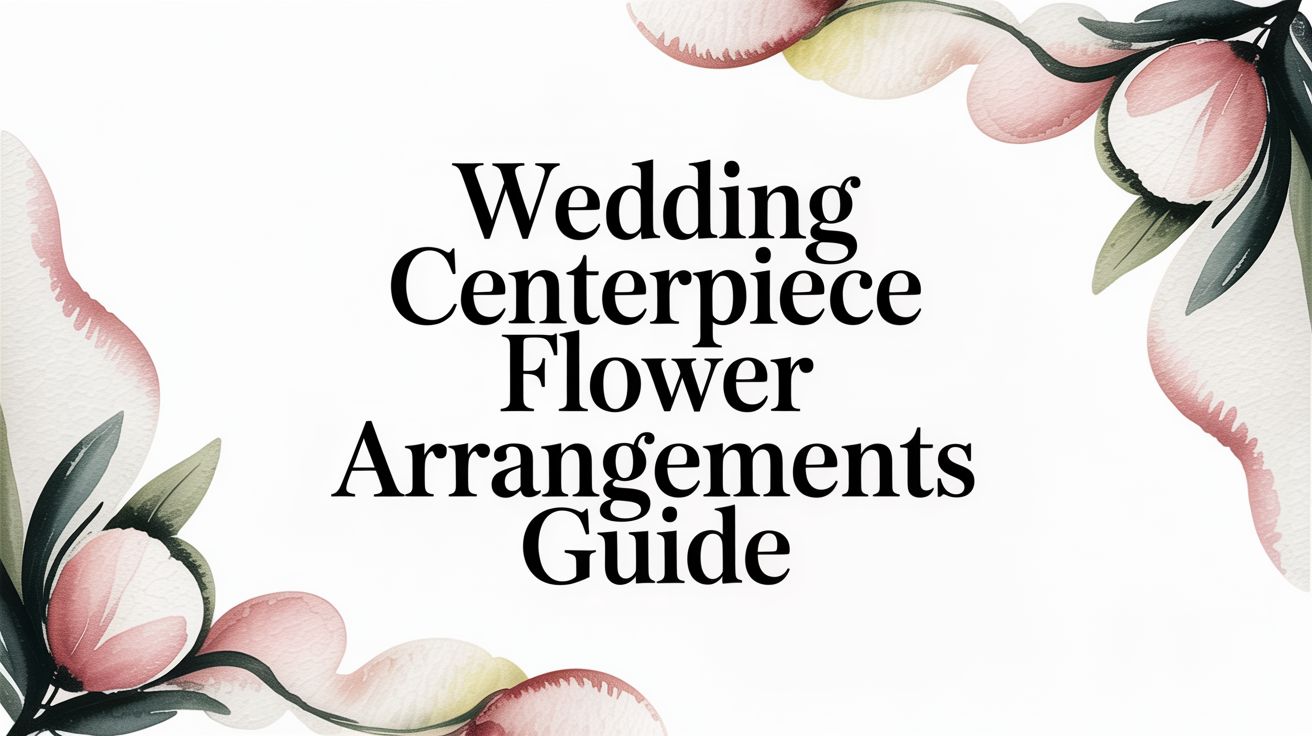When it comes to your wedding reception, the flower arrangements on each table are so much more than just decoration. They’re the heart of the room's atmosphere, the conversation starters, and the threads that tie your entire wedding vision together into one beautiful, cohesive story.
Why Centerpieces Are Your Wedding Storytellers
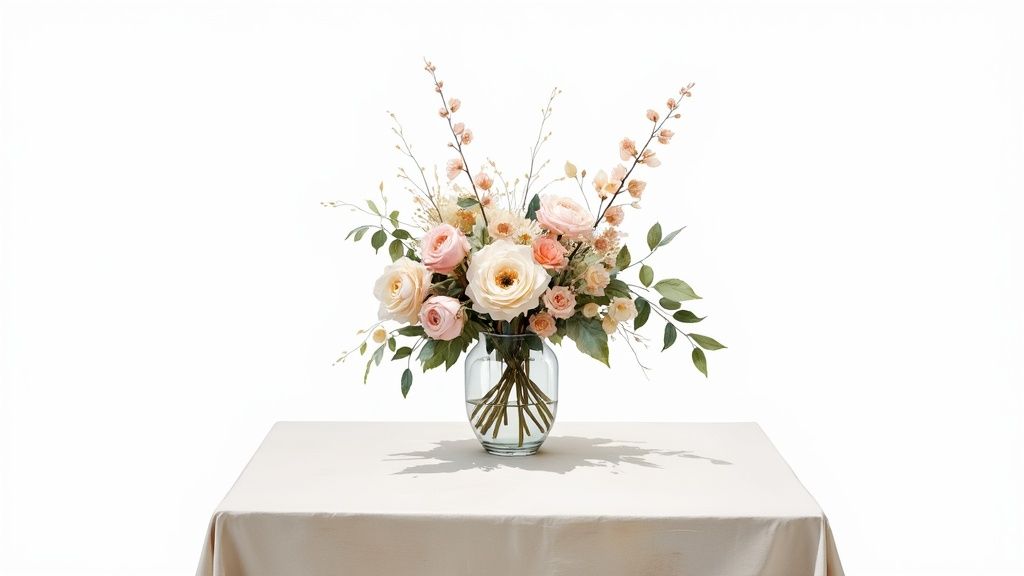
Picture this: you walk into your reception for the very first time as a married couple. What creates that immediate "wow" factor? It’s always the thoughtful details, and your floral centerpieces are leading the charge. They are silent but powerful storytellers, instantly communicating the style and mood of your celebration from the moment guests find their seats.
Think of each arrangement as a miniature installation of your wedding’s theme. For a rustic wedding, you might have wildflowers spilling out of a wooden box. A glamorous, black-tie affair? That calls for tall, elegant orchids in sleek glass vases. This kind of consistency is what creates an immersive experience, making every part of your day feel intentional and seamlessly connected.
Setting the Atmosphere
The right wedding centerpiece flower arrangements are absolutely instrumental in crafting the room's energy. They really guide the emotional tone, whether you're aiming for romantic and intimate, festive and fun, or modern and chic.
Think about how different designs impact the way your guests feel:
- Low, lush arrangements feel intimate and cozy. They’re perfect for encouraging conversation across the table and making guests feel connected.
- Tall, dramatic centerpieces draw the eye upward, adding a real sense of grandeur and sophistication. This works beautifully in venues with high ceilings.
- Clusters of small bud vases have a whimsical, minimalist charm that feels incredibly personal, almost like you gathered them yourself.
These aren't just decorative choices; they're functional parts of your event design that shape the entire experience.
By reflecting your personal journey, your centerpieces become more than just flowers. They transform into meaningful symbols of your story, adding a layer of depth and personality that guests will remember long after the last dance.
Your Personal Touch
Ultimately, these floral designs are a beautiful reflection of you as a couple. This is your chance to infuse your personalities right into the décor. Do you both love peonies? Did you get engaged in a botanical garden? Weaving these little personal narratives into your choices is what makes your wedding uniquely yours.
This guide will be your roadmap. We'll walk through how to translate your vision into a concrete floral style, pick the perfect blooms, build a stunning color palette, and navigate your budget with confidence. My goal is to empower you to create centerpieces that not only look incredible but also tell your one-of-a-kind love story.
Translating Your Wedding Vision into Floral Style
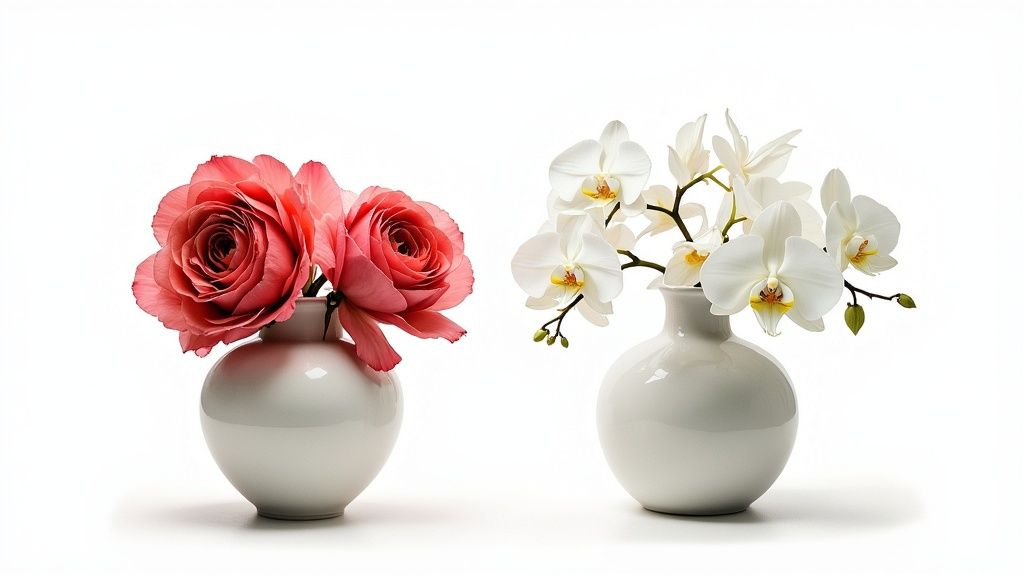
This is where the magic really happens. You’ve got a feeling, a theme, a board full of inspiration… but how do you turn that into an actual centerpiece sitting on a table? It can feel like a huge leap to go from an abstract idea like "romantic" or "modern" to a real, tangible floral design.
Let's bridge that gap. Think of yourself as the creative director of your wedding—your floral style is a direct extension of your personality, the venue, and the whole atmosphere you want to create. We're going to move past vague labels and give you the language to define and communicate your unique aesthetic.
Start with Your Surroundings
Your venue is more than just a backdrop; it's the canvas for your entire day. Its architecture, colors, and overall character are your first and best clues for what kind of floral style will feel right. A design that looks absolutely stunning in one space might feel totally lost or out of place in another.
Take a look around your chosen location and let it guide you:
- A Historic Ballroom with High Ceilings: The space itself is grand, so your flowers should be too. Think tall, elegant arrangements with classic blooms like roses and hydrangeas, maybe with some greenery trailing down to complement the scale and sophistication of the room.
- A Rustic Barn with Wooden Beams: This calls for something more organic and natural. Centerpieces filled with wildflowers, eucalyptus, and other interesting textures in simple vessels—like mason jars or wooden boxes—will feel perfectly at home.
- A Modern Art Gallery or Loft: Clean lines are everything here. Your best bet is a minimalist design that focuses on architectural flowers like orchids, calla lilies, or anthuriums in sleek, geometric vases.
When you work with the venue's existing style, your florals will feel like a seamless part of the experience, enhancing its best features instead of competing with them.
Defining Your Core Aesthetic
Once you have a feel for the space, it’s time to look inward. Your personal taste is the most important ingredient in this whole recipe. Don't feel like you have to squeeze your style into a pre-made box. Instead, use these common aesthetics as a starting point to figure out what truly speaks to you.
A great way to do this is to go back through your inspiration photos. As you look at each one, ask yourself what you really love about it. Is it the soft color palette? The wild, untamed shape? The specific types of flowers used? Pinpointing these patterns is the key to articulating your vision.
Your floral aesthetic is more than just a label; it's the visual language that expresses your personality. By defining it clearly, you empower your florist to become a true partner in bringing your unique wedding story to life through flowers.
Let’s look at how a few of these vibes translate into actual arrangements:
-
Classic & Romantic: This style is all about soft, lush, and abundant florals. Picture overflowing arrangements of peonies, garden roses, and ranunculus spilling out of timeless silver or glass compote bowls. It’s elegant, deeply sentimental, and will never go out of style.
-
Bohemian & Whimsical: Free-spirited and beautifully eclectic. This aesthetic embraces a more "undone" look, often mixing dried elements like pampas grass with fresh wildflowers, dahlias, and tons of textural greenery. The arrangements feel loose, asymmetrical, and effortlessly cool.
-
Modern & Minimalist: Here, it’s all about structure, form, and even the empty space around the flowers. Designs are often simple but incredibly impactful, focusing on a few high-quality, sculptural blooms like Phalaenopsis orchids or anthuriums in stark, simple vases.
-
Glamorous & Luxurious: If you're looking for a touch of drama and opulence, this is it. This style features premium flowers in bold designs—think tall, cascading arrangements, often with metallic accents and a rich, sophisticated color palette. As you plan, an overall luxury wedding guide can be a fantastic resource for tying these high-end details together.
Having this kind of clear vocabulary makes talking to your florist so much more productive. You can confidently explain not just what you like, but why you like it. For even more inspiration, browsing through galleries of fresh flower arrangement ideas can help you find the exact styles that make your heart skip a beat. This homework is the secret to creating centerpieces that feel 100% you.
Selecting Flowers That Tell Your Story
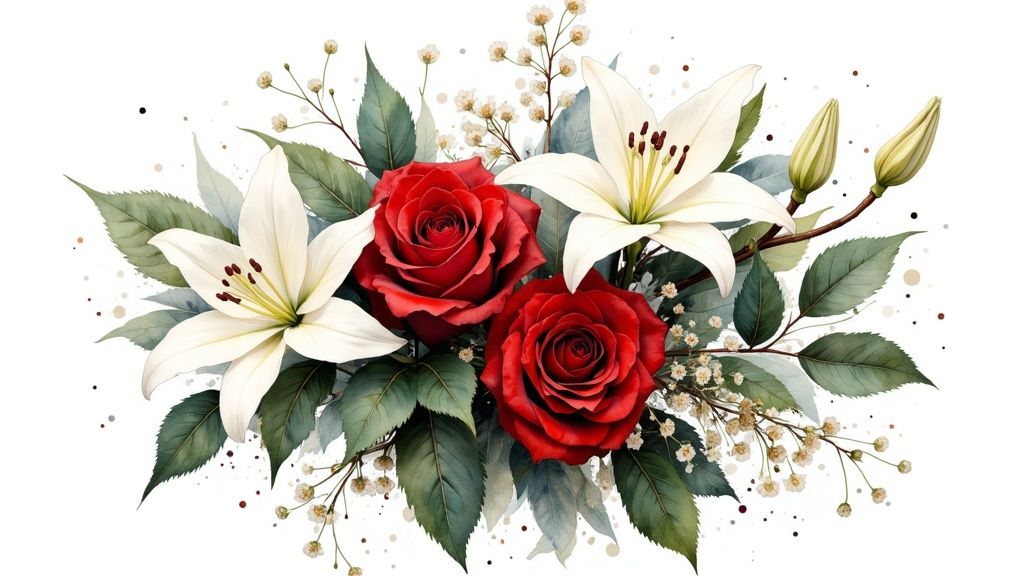
Choosing the flowers for your centerpieces is like casting the main characters in your wedding story. Each bloom brings its own personality and vibe to the table, and this is where the real artistry begins. You're blending your personal style with the practical realities of what's in season to create something truly magical.
Think of your florist as your creative partner, helping you navigate this incredible world of color, texture, and fragrance. The goal isn't just to match your color palette; it's to select flowers that add a deeper layer of meaning to your celebration.
Why Seasonality Is Everything
One of the first conversations you'll have with your florist will be about seasonality. Trust me, this is a big deal. Choosing flowers that are naturally in bloom during your wedding month is one of the smartest moves you can make.
Why? For starters, in-season flowers are at their absolute peak—fresher, more vibrant, and way more durable. Plus, it's a huge win for your budget. When flowers are abundant and easy for florists to get their hands on, the cost naturally comes down. Trying to get peonies in December? It’s possible, but they'll have to be imported, which drives up the price and isn't great for the planet.
Working with the seasons isn't a limitation; it's an opportunity. It ensures you get the most beautiful, highest-quality blooms for your budget while creating a design that feels perfectly in tune with the time of year.
To get you started, here's a quick cheat sheet for some of the most popular wedding flowers and when you can find them looking their best.
Seasonal Guide to Popular Wedding Flowers
This little guide is your starting point for choosing beautiful, in-season flowers that work with your budget and wedding date.
| Season | Popular Focal Flowers | Popular Filler Flowers & Greenery |
|---|---|---|
| Spring | Peonies, Tulips, Ranunculus, Anemones, Sweet Peas, Lilac | Waxflower, Baby's Breath, Spirea, Ferns |
| Summer | Garden Roses, Dahlias, Hydrangeas, Cosmos, Zinnias, Lisianthus | Queen Anne's Lace, Astilbe, Scabiosa, Eucalyptus |
| Autumn | Dahlias, Chrysanthemums, Celosia, Anemones, Protea | Amaranthus, Berries, Pampas Grass, Ruscus |
| Winter | Anemones, Hellebores, Amaryllis, Ranunculus, Tulips | Dusty Miller, Pine, Holly, Silver Brunia |
Remember, this is just a glimpse! Your florist will have a wealth of knowledge about local and unique options available during your specific wedding month.
Deconstructing the Perfect Arrangement
A stunning centerpiece isn't just a bunch of flowers thrown into a vase. It's a carefully crafted composition, where every single stem has a job to do. I like to think of it like putting together an outfit: you have your statement piece, your supporting layers, and your perfect accessories.
Every beautifully designed centerpiece has three key ingredients:
- Focal Flowers: These are the head-turners, the A-listers of the arrangement. Think big, dramatic blooms like peonies, garden roses, or dahlias. They're what your eyes are drawn to first and they set the whole mood.
- Filler Flowers: These are the supporting cast. Smaller, more delicate blooms like waxflower, baby's breath, or statice add texture and volume, filling in the gaps and making the whole arrangement feel lush and full.
- Greenery: This is the foundation that ties everything together. Things like eucalyptus, ruscus, and ferns provide structure, create a beautiful shape, and make those gorgeous focal flowers pop.
When your florist balances these three elements just right, you get a dynamic, gorgeous centerpiece that looks amazing from every single angle.
Flowers That Speak Volumes
Beyond just looking pretty, many flowers carry rich symbolic meanings that have been passed down for centuries. This "language of flowers" is a beautiful, subtle way to add another layer of personal significance to your day.
For instance, you could build your centerpieces around meanings that feel special to your relationship:
- Roses: The timeless symbol of love, of course! But different colors mean different things—red for passionate love, white for purity, and pink for admiration.
- Peonies: These lush, romantic blooms represent a happy marriage, prosperity, and good fortune. What more could you ask for on your wedding day?
- Orchids: Symbolizing love, beauty, and strength, orchids bring an exotic and incredibly elegant touch to any table.
- Lilies: Often associated with devotion and new beginnings, making them a perfect and poignant choice for a wedding.
Choosing flowers for what they represent allows you to weave these quiet messages of love and hope into your décor. It ensures your centerpieces don't just look incredible—they feel deeply connected to you and your story.
Creating a Stunning Centerpiece Color Palette
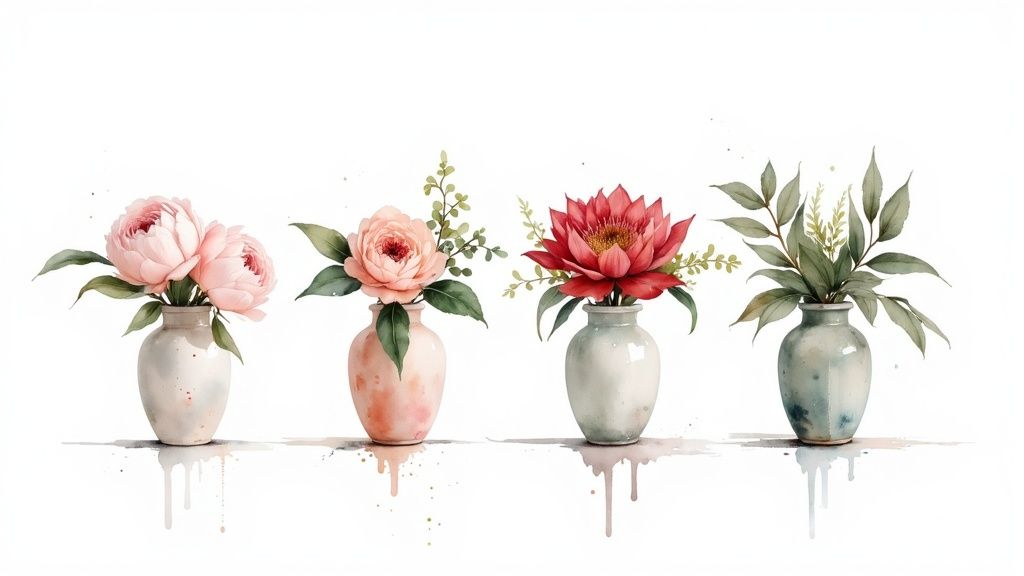
Color is, without a doubt, the most powerful tool you have for setting the mood of your entire wedding. It's the emotional heartbeat of your decor, and your centerpieces are where that color story truly sings. Building a palette might seem like a job for a professional artist, but it’s actually one of the most intuitive and exciting parts of the whole design process.
Think of it like putting together the perfect outfit. You wouldn't just grab random pieces from your closet; you'd select colors and textures that work together to create a specific look and feel. Your floral palette does the exact same thing, pulling the whole room together into one cohesive, beautiful vision.
Understanding Color Relationships
The secret to a knockout palette isn't about throwing a dozen colors into the mix. It's about understanding how a few well-chosen hues play off each other. Let's break down a few foolproof schemes using the language of flowers.
-
Monochromatic: This is all about playing with different shades and tints of a single color. Imagine a centerpiece flowing from the softest blush pink peonies to deep, moody magenta ranunculus. It’s incredibly sophisticated and chic.
-
Analogous: This approach uses colors that sit side-by-side on the color wheel, creating a really harmonious and naturally pleasing look. Picture a sunset—all those yellows, oranges, and reds blending together seamlessly. In a centerpiece, that could be coral charm peonies mixed with soft peach roses and little pops of sunny yellow craspedia.
-
Complementary: If you want a palette that really pops, this is for you. Complementary colors are opposites on the color wheel. The classic example is red and green, but in the floral world, you could pair vibrant blue delphinium with bright orange poppies. The result is dynamic, energetic, and full of life.
These are the foundational tools you'll use to create centerpieces that feel intentional and absolutely stunning.
Drawing Inspiration from Your Surroundings
Your color palette shouldn't exist in a bubble. For the best result, it needs to feel deeply connected to the season, your venue, and the other decor elements you’ve already picked out, like linens and bridesmaid dresses. That connection is what creates a truly immersive experience for everyone.
An autumn wedding, for example, just begs for a rich, warm palette. Taking cues from the season can lead to breathtaking results. For some great examples, you can find tons of inspiration in guides on fall wedding flower ideas that show you how to weave burnt oranges, deep reds, and golden yellows into a gorgeous, cohesive look.
Your color palette should feel like an extension of the environment, not a competitor. When your flowers harmonize with the tones of the venue, the linens, and the season, you create a seamless visual story that feels both elegant and effortless.
A bright, airy venue with white walls is like a blank canvas—perfect for almost any palette you can dream up. On the other hand, a room with dark wood paneling and rich carpets might call for deep jewel tones—emerald, sapphire, and ruby—to play up its inherent drama.
Balancing Hues and Textures
Once you have your core colors, the final piece of the puzzle is balance. A truly great arrangement isn't just about color; it’s about texture and proportion, too. And this is where greenery becomes your absolute best friend.
Greenery isn't just filler—it's a critical balancing element. It gives the eye a neutral place to rest, allowing your colorful blooms to really shine without overwhelming the senses. Varieties like eucalyptus, ruscus, and ivy add softness, create beautiful shapes, and introduce a whole new layer of texture.
To nail that perfect balance, keep these tips in mind:
- Follow the 60-30-10 Rule: This is a classic design principle that works beautifully for florals. Your dominant color should make up about 60% of the arrangement, a secondary color takes up 30%, and a little pop of an accent color fills the final 10%.
- Vary the Tones: Mix light, medium, and dark shades of your chosen colors. This simple trick creates so much depth and visual interest.
- Incorporate Neutrals: Never underestimate the power of white, cream, or even soft grey blooms. They act as "breathing room" in a palette, making the other colors feel even more vibrant.
By getting comfortable with these simple concepts, you can work with your florist to design centerpieces that don't just look amazing, but perfectly capture the emotion and style of your day.
Smart Budgeting for Your Floral Centerpieces
Let's talk money. I know, it's not the most romantic part of wedding planning, but getting smart about your centerpiece budget is the key to bringing your vision to life without any financial stress. Flowers are a gorgeous and significant investment, often making up a big slice of the decor budget for many couples.
Understanding what drives the cost is the first step. It gives you the power to create a plan that perfectly balances your dream aesthetic with your wallet. The U.S. wedding flower market is huge—we're talking a $5 billion industry, and a massive chunk of that goes right into creating those stunning table arrangements. That number alone shows just how central flowers are to the whole wedding experience.
What Influences Centerpiece Costs
So, what actually goes into the final price tag on your arrangements? A few key things. Once you know what they are, you and your florist can make strategic choices together.
- Flower Type: It's simple, really—some flowers just cost more than others. Think delicate, hard-to-ship blooms like lily of the valley or peonies when they're out of season. They'll carry a much higher price than classic, in-season roses or carnations.
- Seasonality: I can't stress this enough: choosing flowers that are naturally blooming at the time of your wedding is your most powerful cost-saving tool. When flowers are in season, they're more abundant, the quality is better, and they are so much more affordable.
- Size and Complexity: This one is pretty straightforward. A tall, cascading masterpiece overflowing with premium blooms will naturally cost more than a few simple bud vases. The labor involved also plays a big part; intricate designs take your florist more time to build, which is reflected in the price.
- Vessel Choice: The vase or container holding your beautiful flowers is part of the cost, too. A simple clear glass vase is always a budget-friendly option, while a custom ceramic bowl or an ornate metallic compote will be more of an investment.
Budgeting for flowers isn't about cutting back; it's about being smart with your allocation. When you understand where the money is going, you can pour it into the details that truly matter most to you. This is how you create maximum impact without overspending.
High-Impact Budgeting Strategies
You absolutely do not need a bottomless budget to have jaw-dropping centerpieces. A little bit of creativity and some smart planning can give you that lush, high-end look while keeping your spending in check.
1. Go Green and Gorgeous
Greenery is a savvy designer's best friend, trust me. Varieties like eucalyptus, Italian ruscus, and all kinds of ferns add beautiful texture, volume, and an organic feel for a fraction of the cost of flowers. A centerpiece that’s 70% greenery and 30% focal blooms can look just as full and stunning as one packed with pricey stems.
2. Repurpose Your Florals
Get more mileage out of every single bloom! Think about how your arrangements can live a second life throughout the event. Can those beautiful ceremony aisle markers be moved to the reception to flank the head table? Can the bridesmaid bouquets pop into vases to decorate the cake table or the bar? It’s a brilliant way to maximize your investment and ensure those flowers are enjoyed all night long.
3. Mix High and Low
Who says every table has to be identical? Consider mixing up your centerpiece styles. You could have a few tall, dramatic arrangements on key tables—like the head table or those near the dance floor—and then use smaller, more understated designs on the rest. This creates so much visual interest and lets you put your money where it will have the biggest impact.
For a wider look at managing your wedding expenses, it's worth exploring some general wedding budgeting tips. When you combine these floral strategies with smart financial planning, you can bring your dream wedding to life in a way that feels both beautiful and responsible.
A Look at the Bigger Picture: Global Floral Trends
When you start picking out flowers for your wedding centerpieces, you're actually stepping into a huge, ever-changing global industry. The flowers you see on your tables are part of a much larger story, one that’s being written by international markets and a real shift in what people value. Knowing a bit about these trends can help you make choices that aren’t just beautiful, but also thoughtful and modern.
This isn't just a small niche, either. We're talking about a massive economic engine. The global wedding flowers market, which includes centerpieces as a key part, was valued at a staggering USD 10.74 billion. It's on track to hit USD 14.01 billion by 2032. This isn't just a number; it shows how much couples all over the world truly care about incredible floral decor for their big day.
The Move Toward Sustainable Floristry
One of the most exciting shifts we're seeing in floral design is the move toward sustainability. It's a real movement. More and more, couples and designers are starting to ask the important questions about where their flowers are coming from. This has led to a wonderful rediscovery of locally-sourced, seasonal blooms.
Choosing local flowers comes with some amazing perks:
- Peak Freshness: When flowers don't have to travel thousands of miles, they're just plain fresher. They last longer and their colors are so much more vibrant.
- Community Support: You're putting your money right back into your own community, supporting local growers and small businesses.
- A Lighter Footprint: It drastically cuts down on the environmental cost that comes with flying flowers halfway around the world.
This eco-conscious way of thinking goes beyond just the flowers. Many florists are ditching floral foam—that green stuff that’s basically a single-use plastic—for more sustainable techniques like chicken wire, classic flower frogs, and simple water-filled vases. For a beautiful example of this in action, take a look at our guide to stunning winter wedding floral arrangements, which often celebrate hardy, local elements.
Going sustainable doesn’t mean you have to compromise on style. In fact, it often pushes us to create more unique, personal designs that truly reflect the season and your location. It creates a much deeper, more meaningful connection between your wedding and the world around it.
Answering Your Top Wedding Centerpiece Questions
When you start diving into the world of wedding florals, a lot of questions pop up. It’s completely normal! From when to book your florist to whether you should go big with tall arrangements, getting clear answers makes the whole process feel less overwhelming and way more fun.
We’ve heard just about every question in the book, so we’ve rounded up the most common ones to help you plan with confidence. Let’s get you some answers.
How Far In Advance Should I Book My Florist?
Timing is everything, especially in the wedding world. We always suggest booking your floral designer 8-12 months before your wedding. This is your golden window.
Why so early? If you’re getting married during peak season (think late spring through early fall) or on a holiday weekend, the best designers get booked up fast. Locking in your florist early means you get your first choice, and more importantly, it gives your creative team plenty of time to dream up your designs, source any unique flowers you want, and really nail your vision. It's about securing a partner for one of the most beautiful parts of your day.
Should I Choose Tall or Low Centerpieces?
Ah, the great debate: tall versus low. The truth is, there’s no right or wrong answer—it all comes down to your venue and the vibe you’re going for. They each bring something different to the table, literally.
-
Tall Centerpieces: These are your showstoppers. They create immediate drama and elegance, drawing the eye up. If you’re in a venue with soaring ceilings, tall arrangements are perfect for filling that vertical space and making the room feel incredibly lush and grand.
-
Low Centerpieces: These are all about intimacy. Keeping the flowers below eye level encourages conversation and connection, letting your guests easily chat across the table. They help foster a warm, welcoming atmosphere.
Our favorite approach? A mix of both! Alternating between high and low designs adds so much visual interest and rhythm to the room, creating a dynamic look that feels custom and thoughtful.
How Can I Make My Centerpieces More Personal?
This is where the magic really happens. Your centerpieces shouldn't just be pretty; they should feel like you. Infusing them with personal details is what turns a simple arrangement into a piece of your story.
Think beyond just the blooms and consider weaving in elements that mean something to you as a couple:
- Vessels with a Story: Choose vases that echo your home’s decor style or maybe something you’ve collected together.
- Meaningful Objects: A subtle nod to a shared passion—like a small stack of your favorite books or a vintage camera—adds so much charm.
- Candlelight: Nothing says romance like candles. Whether you love the elegance of tall tapers or the soft glow of scattered votives, lighting adds warmth and dimension.
Personalization is all about layering in meaning. It’s those unexpected, thoughtful details that your guests will notice and remember long after the last dance.
Is It Worth It to DIY My Centerpieces?
The DIY route can seem like a great way to save money, and for some, it can be a really rewarding project. But it's so important to go into it with your eyes wide open. Designing and creating your own centerpieces is a massive undertaking.
You're not just arranging flowers. You’re responsible for sourcing, hydrating, and processing every single stem, then assembling everything in the days leading up to your wedding—a time that’s already a whirlwind of activity. For just 30 centerpieces, you could easily need close to 500 individual stems. That’s a lot to manage on top of everything else. Before you commit, seriously weigh the potential savings against the time, stress, and sheer amount of work involved.
At Fiore, we live for crafting custom wedding centerpieces that tell your unique love story. Let our team of expert designers in Los Angeles handle every floral detail, so you can focus on what truly matters. Explore our wedding floral design services and let’s start dreaming together.
